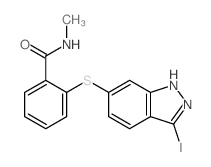1/2
Axitinib NEW
- Min. Order1KG
- Purity98%
- Cas No319460-85-0
- Supply Abilityg-kg-tons, free sample is available
- Update time2024-03-26

| Product Name | Axitinib |
| CAS No | 319460-85-0 |
| EC-No | |
| Min. Order | 1KG |
| Purity | 98% |
| Supply Ability | g-kg-tons, free sample is available |
| Release date | 2024/03/26 |
1. Materials information
Names
| Name | axitinib |
|---|---|
| Synonym | More Synonyms |
Axitinib Biological Activity
| Description | Axitinib is a multi-targeted tyrosine kinase inhibitor with IC50s of 0.1, 0.2, 0.1-0.3, 1.6 nM for VEGFR1, VEGFR2, VEGFR3 and PDGFRβ, respectively. |
|---|---|
| Related Catalog |
Signaling Pathways >>
Protein Tyrosine Kinase/RTK >>
PDGFR
Signaling Pathways >>
Protein Tyrosine Kinase/RTK >>
VEGFR
Research Areas >>
Cancer
|
| Target |
VEGFR1:0.1 nM (IC50) VEGFR2:0.2 nM (IC50) VEGFR3:0.1 nM (IC50) PDGFRβ:1.6 nM (IC50) |
| In Vitro | Axitinib (AG-013736) is a potent and selective inhibitor of VEGFR 1 to 3. In transfected or endogenous RTK-expressing cells, Axitinib potently blocks growth factor-stimulated phosphorylation of VEGFR-2 and VEGFR-3 with average IC50 values of 0.2 and 0.1 to 0.3 nM, respectively. Cellular activity against VEGFR-1 is 1.2 nM (measured in the presence of 2.3% bovine serum albumin), equivalent to an absolute IC50 of ~0.1 nM, based on protein binding of Axitinib. The potency against murine VEGFR-2 (Flk-1) in Flk-1-transfected NIH-3T3 cells is 0.18 nM, similar to that of its human homologue. Axitinib shows ~8- to 25-fold higher IC50 against the closely related type III and V family RTKs, including PDGFR-β (1.6 nM), KIT (1.7 nM), and PDGFR-α (5 nM); nanomolar concentrations of Axitinib blocks PDGF BB-mediated human glioma U87MG cell (PDGFR-β-positive) migration but not proliferation[2]. |
| In Vivo | A single oral dose of Axitinib (100 mg/kg) markedly suppresses murine VEGFR-2 phosphorylation for up to 7 h compared with control tumors. Axitinib rapidly inhibits VEGF-induced vascular permeability in the skin of mice; the inhibition is dose-dependent and directly correlated with drug concentration in mice. Pharmacokinetic/pharmacodynamic analysis indicate an unbound EC50 of 0.46 nM. Similar inhibitory effects are also shown in the skin of MV522 tumor-bearing mice without exogenous VEGF-A stimulation. Axitinib inhibits the growth of human xenograft tumors in mice. Axitinib produces dose-dependent growth delay regardless of initial tumor size, model type, or implant site[2]. |
| Cell Assay | Endothelial or tumor cells are starved for 18 h in the presence of either 1% FBS (HUVEC) or 0.1% FBS (tumor cells). Axitinib is added and cells are incubated for 45 min at 37°C in the presence of 1 mM Na3VO4. The appropriate growth factor is added to the cells, and after 5 min, cells are rinsed with cold PBS and lysed in the lysis buffer and a protease inhibitor cocktail. The lysates are incubated with immunoprecipitation antibodies for the intended proteins overnight at 4°C. Antibody complexes are conjugated to protein A beads and supernatants are separated by SDS-PAGE[2]. |
| Animal Admin | Mice and Rats[2] Mice with M24met xenograft tumors (400-600 mm3) are administered with a single dose of Axitinib or the control (0.5% carboxymethylcellulose/H2O). Blood and tumor tissue samples are collected for pharmacokinetic and VEGFR-2 measurements. Total protein concentrations in tumor tissues are determined using the Bradford colorimetric assay. Six-day-old Sprague-Dawley rats are given two i.p. injections of Axitinib (30 mg/kg ). Animals are sacrificed, retinas are collected and lysed, and immunoprecipitation/immunoblotting experiments are done. ECL-Plus is used for detection and densitometry analysis is done using the Alpha Imager 8800. |
| References |
Chemical & Physical Properties
| Density | 1.4±0.1 g/cm3 |
|---|---|
| Boiling Point | 668.9±55.0 °C at 760 mmHg |
| Melting Point | 213-215ºC |
| Molecular Formula | C22H18N4OS |
| Molecular Weight | 386.470 |
| Flash Point | 358.3±31.5 °C |
| Exact Mass | 386.120117 |
| PSA | 95.97000 |
| LogP | 4.15 |
| Vapour Pressure | 0.0±2.0 mmHg at 25°C |
| Index of Refraction | 1.728 |
| Storage condition | -20°C Freezer |
MSDS
|
Axitinib MSDS(Chinese)
|
Safety Information
| Symbol |


GHS07, GHS09 |
|---|---|
| Signal Word | Warning |
| Hazard Statements | H302-H400 |
| Precautionary Statements | P273 |
| Hazard Codes | Xn,N |
| Risk Phrases | 22-50/53 |
| Safety Phrases | 60-61 |
| RIDADR | UN 3077 9 / PGIII |
| HS Code | 2933990090 |
Precursor & DownStream
| Precursor 2 | |
|---|---|
| DownStream 0 | |
Customs
| HS Code | 2933990090 |
|---|---|
| Summary | 2933990090. heterocyclic compounds with nitrogen hetero-atom(s) only. VAT:17.0%. Tax rebate rate:13.0%. . MFN tariff:6.5%. General tariff:20.0% |
2. Packaging of materials
For powders: normal is 25kgs/Drum or bag, or larger/smaller package as request.
For liquids: normal 25kgs/drum, 180-300kgs/bucket, or IBC, determined by the nature of the product.
Or smaller package 1kg/bottle, 10kgs/bottle as request.


3. Shipping & Delivery
By Express
Provide door to door service
Suitable for goods under 50kg
Delivery: 3-7 days
Cost: low cost

By Air
Provide airport to airport service
Suitable for goods over 50kg
Delivery: 3-14 days
Cost: high cost

By Sea
Provide seaport to seaport service
Suitable for goods over 100kg
Delivery: 2-45 days
Cost: low cost

4. Contact information
For more details, pls contact us freely.
Email address: Tina@fdachem.com
Mob: 86 15225627621
WhatsApp/Skype/Wechat/LINE: 86 15225627621
Company Profile Introduction
Henan Fengda Chemical Co., Ltd. is located in the High-tech Development Zone of Henan Province. Specializing in the production and sales of various fine chemical products required for industrial production, including chemical raw materials, organic raw materials, petrochemicals, chemical reagents, solvents, catalysts, and additives, etc.


 CAS#:100-69-6
CAS#:100-69-6 CAS#:885126-34-1
CAS#:885126-34-1
